

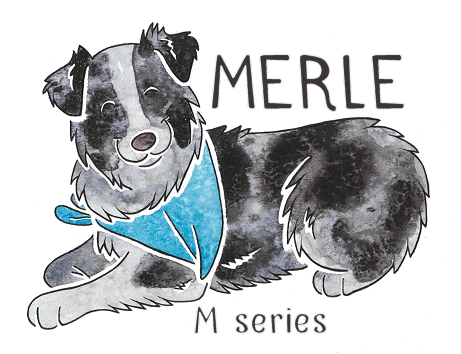

Already know what you're looking for? Quick Links | |

The Merle Gene (continued)
(Further examples of interactions with other loci)

Disclaimer
Merle is a fascinating and varied coat pattern, and there is no doubt that many of the merles shown further down this page are beautiful, unusual and exotic. However, the pictures and information are provided entirely for educational purposes and I do not in any way condone the breeding of dogs deliberately for colour, or breeding for colours or patterns that are not on the breed standard.
The primary concerns for any dog breeder must be health, temperament and conformation. Colour should only be a consideration where it is important for the breed standard. Special care must also be taken when breeding merles to avoid health problems, so merle is a colour best left to very experienced dog breeders. If you are considering breeding a merle dog then please make sure to read all of the information on merle, and consider testing before you go ahead to ensure that your breeding is safe.

Liver Merles
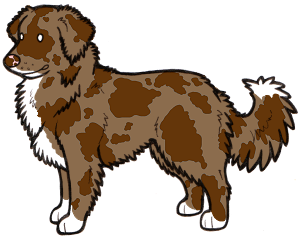
A normal "blue" (i.e. black) merle becomes a "red" merle when it has bb on the B locus, i.e. when it has the liver gene. "Red merle" is also a misleading term because "red" is usually used to refer to phaeomelanin (tan, gold, cream etc) rather than eumelanin. A red merle should correctly be called a liver merle.
Liver turns all of the patches on a blue merle into brown and the colour between the patches becomes pale brown, a similar shade to isabella. Liver merles can have dilute patches, blue or wall eyes, and butterfly noses, just like any other merle.
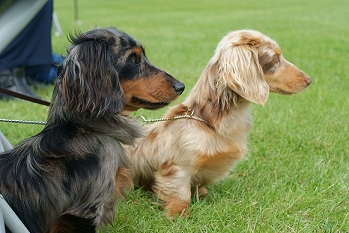
The Dachshund at the back of this photo is a red (liver) merle with tan points, and the Dachshund in the front is a normal blue (black) merle with tan points.

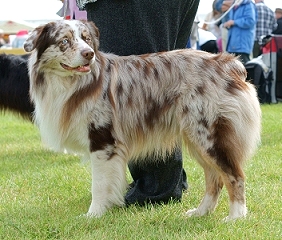
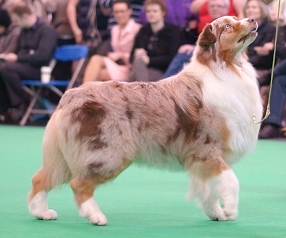
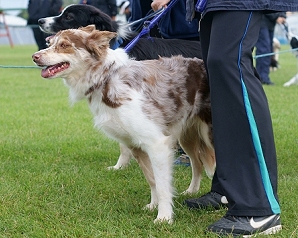
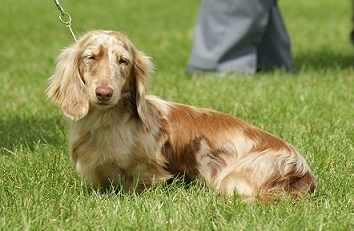
More examples of liver merles (with tan markings and with or without white).

Dilution
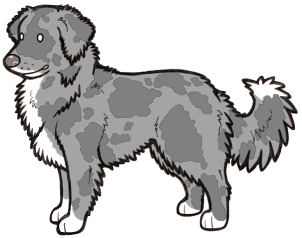
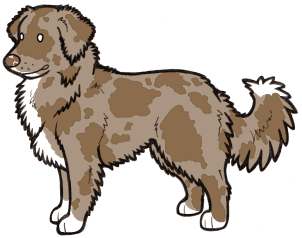
A dilute is a dog that is dd on the D locus. dd turns a black dog into a blue dog (with a blue nose and amber eyes) and a liver dog into an isabella. A merle with the dilution gene will appear very washed-out. The black or liver patches will be diluted almost to the same shade as the base colour. So a blue merle (a true blue merle with the dilution gene, not a black merle!) will appear almost completely light grey with some faint darker grey patches, and an isabella merle will be light greyish brown with faint darker brown patches. On a longhaired dog, it can be next to impossible to tell a blue or isabella merle from a non-merle. To distinguish between a merle with dilution and a merle with greying (which produces much the same effect on the patches in the coat - see below), look at the nose. If the dog has a blue nose, it has the dilution gene.

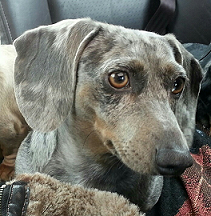

This Smooth-haired Dachshund, submitted by Tracy Buck of Low-Rider Mini Dachshunds, is a true "blue" (dilute) merle. In some breeds, dogs like this one are known as slate merles.

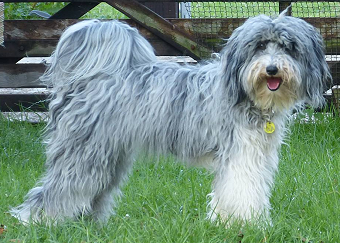
Angel, submitted by Natalie Lagstrom, is a normal "black" merle with greying. The black areas on the coat have faded to a blue-ish grey, however her nose and lip pigment is still black. Of course, it's possible for a dilute merle to have greying too, and such a dog would be even paler than Angel, with pale pigment to match.

Tan Markings
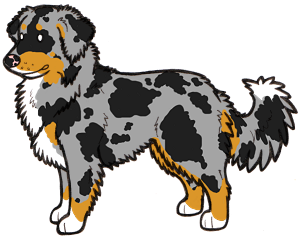


Merles can come with or without any of the tan patterns (A locus). The most common is normal tan points, but creeping tan and saddle patterns also occur (tan points plus a modifier).
All dogs that show non-brindled tan markings must be kyky on the K locus (KB is dominant black, so if a dog has even one copy of it then they will be solid black, or solid merle if they are also Mm, regardless of what they have on the A locus). A tan pointed dog will be atat on the A locus (tan points are recessive and only dominant over recessive black, a, so a dog must have two at genes to display tan points). Modifiers then turn the tan points into creeping or saddle tan on some dogs.
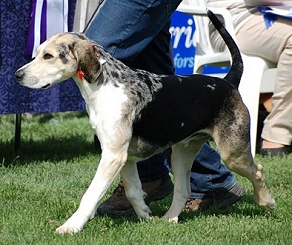
The Norwegian Dunker is one of the only breeds where the saddle pattern and the merle gene occur together. This dog's pattern is between
creeping tan and saddle. You can see that the merling covers the back, the tail, the back of the neck and the top of the head. The tan is very light and
so is probably affected by the Intensity, which lightens red. This dog also has white in the irish spotting pattern. Photo taken by June.

Masks
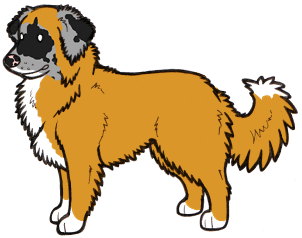
A dog that has at least one Eme allele on the E locus will have a mask (Em, the
mask gene, is dominant over the rest of the series). The mask can be black, liver, blue or isabella depending on the dog's pigment. If the dog also has the merle gene, the mask will
be merled. Because of this, masks are not visible on solid merle dogs - they're just merled like the rest of the coat. However, tan-pointed merles with
little to no face white sometimes display masks (recognisable because the areas which should be tan on the muzzle are merled instead), and sable (ayay)
dogs have masks which are much easier to see. The illustration here shows a masked clear sable merle.
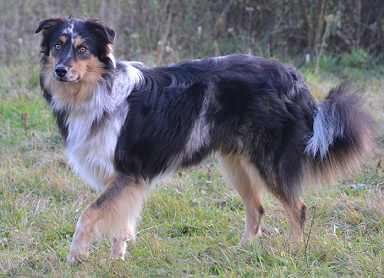
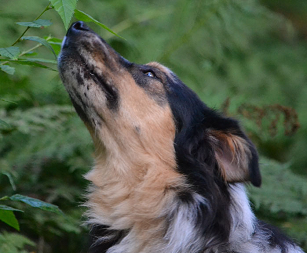
Photo by Hillary Livaccari
This beautiful tan-pointed merle has a small mask. On the second photo, you can see clear merling on the chin where the mask should be.

Sable
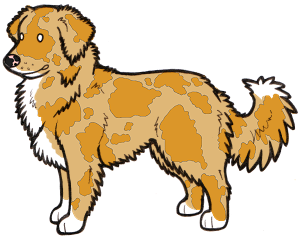
A dog with at least one Ay allele on the A locus and kyky on the K locus (allowing for the A locus markings to be visible) will
be a sable. Sables are solid red with or without black tipping. Sometimes, especially if sable is combined with a mask, the black tipping can be quite
extensive and can cause large black areas on the back, head and tail. In a sable merle, all of these black areas are merled. As you can imagine,
how obvious it is that a dog is a sable merle depends heavily on how much black tipping they have. A sable merle with no black tipping (a "clear sable") will just appear
to be a solid sable, possibly with one or two blue eyes (the only indication that they are a merle).
In some breeds, such as Shetland Sheepdogs and Rough Collies, a slightly different version of sable exists. This type consists of brownish hairs on the
back and head (even though these dogs have black pigment), and is often called "shaded sable". On this type of sable coat, merling can be quite visible (if there is a lot of dark brown shading)
or very hard to see (if the shading is lighter and not so extensive). However, the merling is usually visible at birth, so breeders will generally know if
their dogs are sable merles or just sables. A shaded sable merle will have some faint, darker brown/tan patches on a lighter base, and the merling will usually be confined to the
back and head. It is often most visible on the ears, where the fur is shorter.

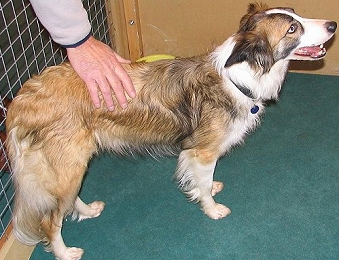
This is a sable merle Border Collie with black tipping and a mask. His most obvious merle trait is his blue eyes, but a small light grey area is also
visible on his cheek. If you look closely, he has some silver hairs on his back where the black tipping is merled, and another hint is that the
black tipping isn't spread evenly - it's patchy and seems to be more down the side of the shoulder than on the back, where it would normally appear, suggesting
that the black hairs which should be present on the top of the shoulders have been turned to grey (which is not very visible against the red coat).

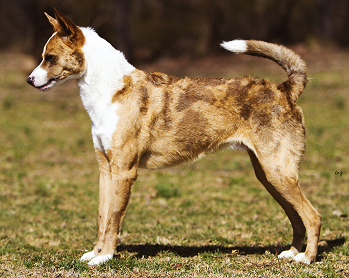
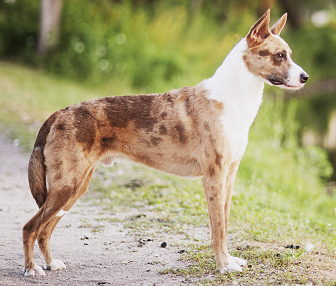
Dexter the Catahoula Leopard Dog cross, photos by Olivia Frost
Dexter is a shaded sable merle. Unusually for a sable merle, he has very distinct dark patches on his body. Compare to the tipped sable merle Border Collie above and you'll see that the overall effect is very different, even though both dogs are AyAy.

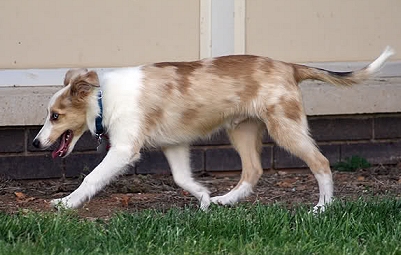
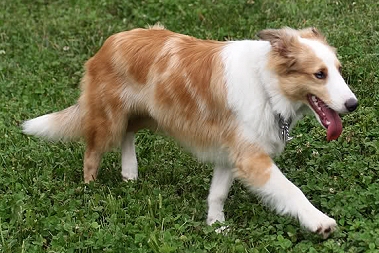
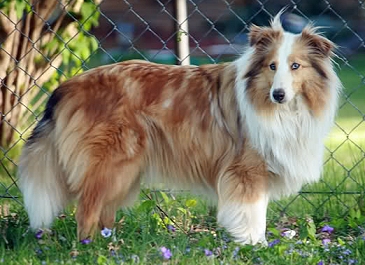
Simon the Shetland Sheepdog, photos by Brandee Massey
Simon is also a shaded sable merle. These pictures show him from five months to 2 years old. His shorter puppy coat displays the merle much more clearly than his longer adult coat.

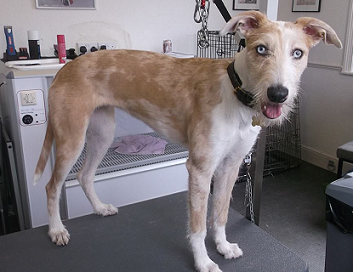
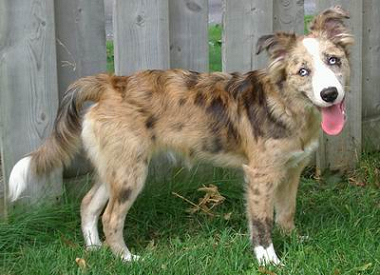
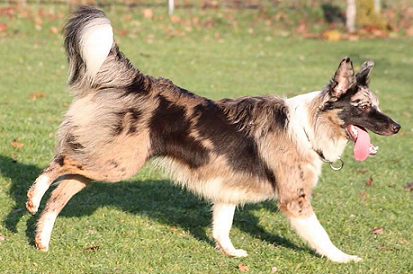
Above are three stunning sable merles, showing the full range in appearance of this pattern. The pale-coloured Lurcher is Indigo, owned by Sarah Henderson. Without the merle, he would probably be a clear sable as he doesn't seem to have any black shading visible. The second dog is Fetish the Border Collie, owned by Judy Rolff. Without the merle, Fetish would be a medium-shaded sable, probably similar to many Rough Collies. The third dog is owned by Tamara Gerritsen of A Breeze For Bliss Border Collies, and shows very heavy shading. This dog has such dark black areas that it's possible it is in fact a seal merle (dominant black overlaying sable).

Agouti
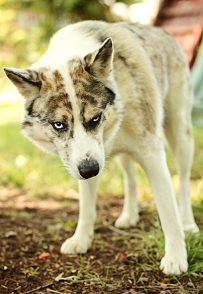
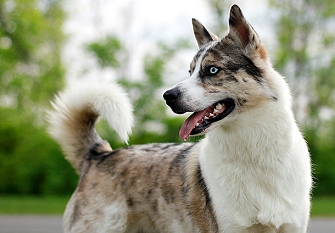
Haiku the Husky mix, photos by Dariana Kamenova
Haiku above shows beautifully the effect of merle on agouti (aw). The agouti pattern consists of banded hairs scattered over the dog (and mostly concentrated on the head and back). As only the black (eumelanin) parts are affected by the merle gene, the overall effect of merle on agouti is of scattered small black spots and flecks, with some patterns forming where the black would usually be on the agouti (as can easily be seen in the photo of Haiku to the front, where the spots on his head form lines). These two alleles do not generally occur within the same breeds, so agouti merle is rare and is usually seen on Husky crosses.

Brindle
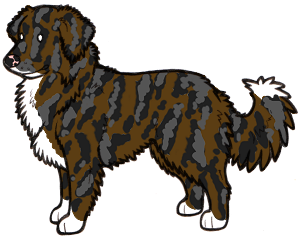
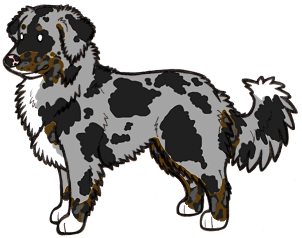
If a dog is kbrkbr (or kbrky, because kbr is dominant over ky) on the K locus then any phaeomelanin (red) in their coat will be brindled. This applies to merle dogs too - there is no reason why a merle cannot also have brindle. If a merle dog has the brindle allele and also has atat on the A locus then it will be merle with brindled tan points. If a merle dog has brindle and AyAy (sable), it will be solid red with brindling all over (and possibly with larger areas of black than is normal for a brindle on the back and/or head, if the sable has dark shading). The brindle in both the brindle-pointed merle and the solid brindle dog will be broken up into uneven spots rather than being complete stripes. This is because the stripes on a brindle are eumelanin (affected by merle, so random parts are diluted) and the base is phaeomelanin (not affected by merle).
How easy a solid brindle merle is to identify depends on both the amount of brindling and the amount of merling. If you can imagine, a brindle with very heavy eumelanin striping would be more likely to show merling than a brindle with very light striping, simply because the first dog has more eumelanin in its coat to start with (and only the eumelanin is affected by merle). Imagine also the range in patch sizes on a merle on top of this - a merle with lots of dilute areas will result in more broken-up brindle stripes than a merle with very large undiluted areas. As a result of this variation, some brindle merles can be almost indistinguishable from a normal brindle.
When a merle dog has just brindle points it can be even harder to recognise because the stripes are even less visible. The points will generally have a few black spots on them and will appear a darkish, muddy brown.

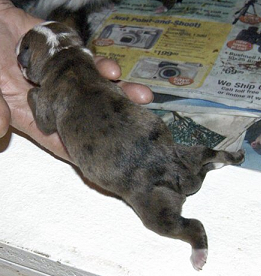
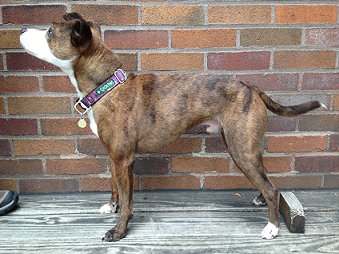
This crossbreed (Staffordshire Bull Terrier x Mini Australian Shepherd) shows clear merle spots as a pup, but as an adult he's much harder to identify as a merle and could easily be mistaken for a normal brindle. This shows the dangers of merle in breeds that also have the brindle allele, as this dog could easily be accidentally bred to another merle. Dogs whose merle is "masked" by another allele, such as brindle or recessive red, are sometimes called phantom merles. Pictures submitted by Ally Stern.

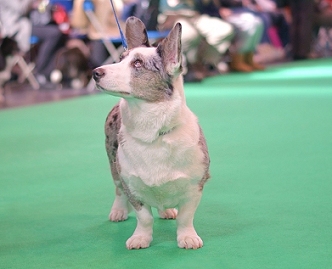
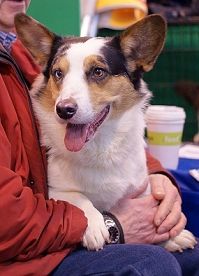
The Cardigan Welsh Corgi is one of the few breeds where brindle and merle regularly occur together (the other main one being the Catahoula Leopard Dog). The
dog on the left has tan points, but they are very dull and brownish compared to normal tan points (see the dog on the right, which does not have the brindle allele). This points
to this dog being a brindle-pointed blue merle, which is very common in the breed. The brindle appears only on the points, where it is broken up by the merle gene. In this case, the dog is a very light-marked merle, so the points are very washed out with few spots. Brindle can also appear on merles with the creeping tan and saddle patterns.

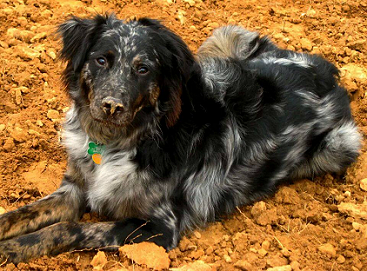
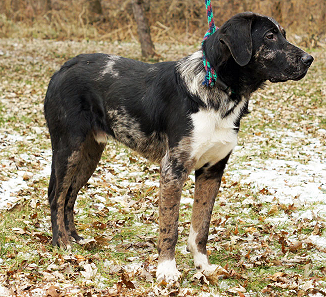
First photo submitted by Brooklyn Hjerpe, second by Jamie Elvert
The brindle points on the Australian Shepherd and mixed breed here are much more obvious, with clear merle patching/spotting on the legs of both dogs. Merle spotting won't usually appear on tan points unless brindle is present, although sometimes if the points appear very dark then they may actually be caused by ghost tan (see the K locus page). The merle lifts some of the black overlay, causing a similar effect to brindle points.

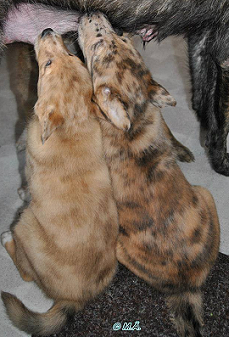
Photo submitted by Kata Mononen
Sable merle (left) vs brindle merle (right). The patterns are not always easy to tell apart, as the dogs below show.
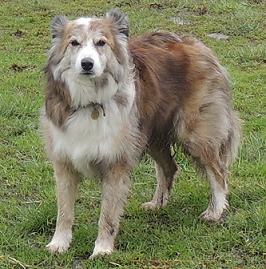
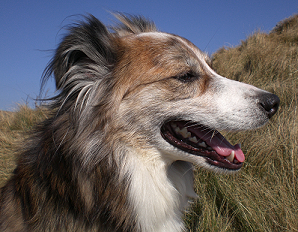
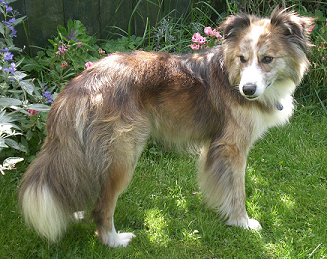
Photos submitted by Jenny Clapham
Ben the Welsh Collie could easily be mistaken for a sable merle, but he is more than likely a brindle merle, as there appears to be faint brindling on his face and front leg and he has that typical "muddy brown" colouration.
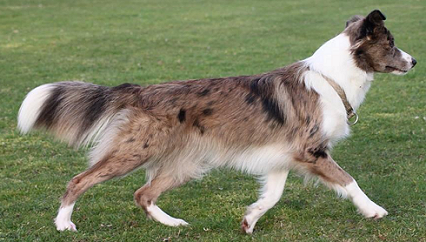
Photo submitted by Tamara Gerritsen
The "muddy"-looking brownish base coat on this dog is strongly associated with brindle merles as opposed to sable merles, which tend to have a lighter and clearer red/tan colour.

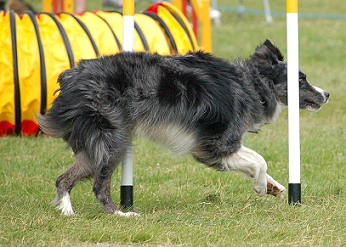
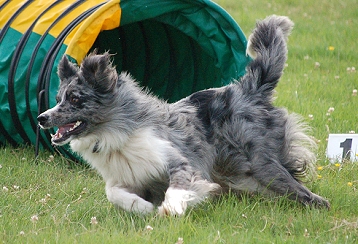
Photos by Cat of Dog Rad Design
These two merles demonstrate how tricky it can be to identify brindle points. If you look closely you can see muddy brown areas on the legs and muzzle, with black flecks and spots. These dogs have much less clear points than the examples above, with a less rich tan, so it's most likely they actually have non-brindled "ghost" tan (see K Locus page).

Seal
Seal is thought to occur when the KB allele does not fully "cover" sable, resulting in a brownish black, and is possibly either a variant of the KB allele or a modifier of KB. See the K Locus page for more information and examples of seal.
Black seal can vary from a slight brown cast on the coat, to a shade resembling liver. When combined with the merle gene, this can create a wide range of different effects.
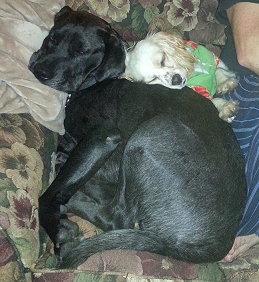
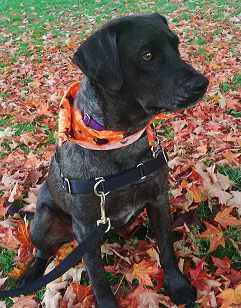
Luke, submitted by Kristine Guenther, is a very subtle seal merle. From a distance he looks mostly black, but if you look closely you can see black spots on his slightly brownish coat (particularly on the first image here).

Rocky Road Palmer, submitted by Karen Palmer, is also probably a seal merle, but a much more obvious one than Luke above. Note how his legs are dark (a common feature of the seal pattern), and his patches are brownish rather than solid black.
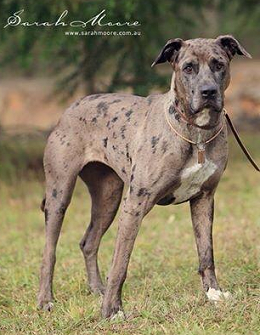
Seal merle and brindle merle can be very difficult to tell apart, as you can see on this photo of Leilani-Elan, taken by Sarah Moore. Leilani-Elan could be either brindle or seal, as the distinctive muddy brownish base coat can be associated with either and there is no obvious striping.

Ticking
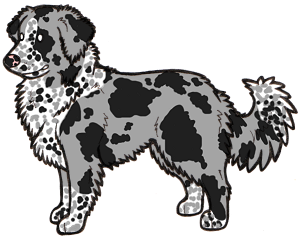
A dog with TT or Tt on the T locus will have ticking on any white areas in their coat. It is thought that TT produces roan or heavy ticking and Tt produces lighter ticking. Ticking will only show up on a merle if it has white markings, and the ticking will be a mix of the merle base colour and the patch colour (so in a blue merle, black and grey). As you can see from the example below, it can be difficult to see the difference between ticked and merled areas on a dog.
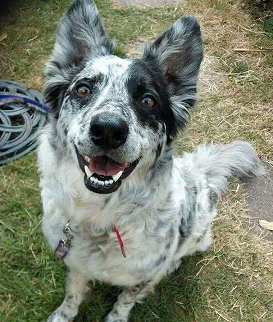
Mist, submitted by Leanne


** Please note that I am not a research scientist, and the information on this page comes from my own knowledge and observation of dogs, observational and testing data provided via e-mail by site visitors, any research papers linked on the page, and the information provided by Dr Sheila M. Schmutz on her excellent website http://homepage.usask.ca/~schmutz/dogcolors.html
For further genetics resources, see the Links page